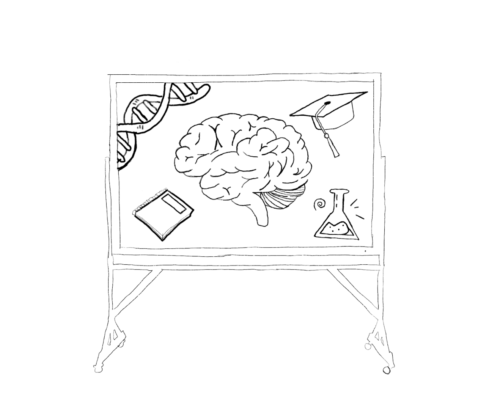A cure for Parkinson’s and Alzheimer’s diseases may have been hiding from neuroscientists for decades. As Harvard students prepared for back-to-school, researchers at the University of Lausanne were glued to the microscope as they discovered a new type of brain cell, glutamatergic astrocytes. As a hybrid of two well-studied cells—neurons and glial cells—these specialized astrocytes may have the capacity to cure memory disorders and prompt an interesting challenge for neuroscience and psychology professors alike. So, how do Harvard professors adapt their courses in the face of new research?
“Because cognitive neuroscience is the newest area of psychological science, it is the area that changes most rapidly,” said Daniel Gilbert, Harvard Professor of Psychology. To adapt to the constantly evolving fields of psychology and neuroscience, Harvard professors must always keep their classes and textbooks updated to ensure their students are taught the most recent material. “Being a scientist is about not knowing the answers, exploring, and stumbling into the unexpected,” said Nicholas Bellono, Associate Professor of Molecular and Cellular Biology.
Though these scientists are expert researchers in their fields and experienced professors, the discovery of the glutamatergic astrocyte is just one example of a groundbreaking discovery that transforms not only the curricula of these renowned professors but also their own understanding of their respective fields.
It is crucial to weave discoveries into the time-honored curricula to fully foster the student’s understanding of where the field is headed and what kinds of research are within reach. “I incorporate many recent scientific discoveries in my talks because we use rapidly and constantly evolving technologies, improving our understanding of genes, proteins, cells, and how the brain works in healthy and diseased states,” said Bruno Benitez, Assistant Professor of Neurology.
Introductory courses in neuroscience and psychology focus on the brain’s basic mechanics. Students are taught early on that neurons are prominent cells that rapidly transmit information and glial cells perform various supportive functions to neurons. Many glial cells cluster around the neural synapse, causing neuroscientists and psychologists alike to argue whether astrocytes play an active role in information processing, though previous studies have proven inconclusive. The discovery of the glutamatergic astrocyte has settled the debate once and for all; astrocytes both perform support functions as a glial cell does and can process information as a neuron does.
Because glutamatergic astrocytes regulate brain circuitry and movement control, they may play a role in future therapeutic interventions for Parkinson’s disease. Ambitious researchers have even proposed testing these astrocytes for their ability to fight Alzheimer’s after discovering rats whose glutamatergic astrocytes were tampered with experienced impaired memory. Even though a long way away, treatments for both diseases would revolutionize the treatment of neurological disorders.
In other words, modern neuroscience and psychology fields were virtually upturned overnight.
“Science is the slow accumulation of knowledge that is in a constant state of revision, so the content of a science course or a science textbook naturally changes at least a bit year to year,” said Gilbert.
Most neuroscience and psychology professors must often update their lectures and textbooks to account for recent scientific discoveries. When asked how scientific evolution impacts his teaching and textbook, Gilbert said, “Our textbook is revised every two to three years, and I revise my course lectures every year. Often, this involves adding some new studies and removing some old ones, but sometimes, it requires a major change because we’ve gained some new understanding of a phenomenon or found out that our old understanding was wrong.” Though a newly solidified fact of neural anatomy, the glutamatergic astrocyte is a classic example of a significant change to neuroscience and psychology and, in turn, Harvard’s curricula.
Some professors keep their students current by scheduling weekly meetings to discuss discoveries. Bruno said, “We have a weekly journal club in our lab meetings where we critically discuss new and promising research papers. I have set up several alerts for new papers on topics of interest.” This dedication ensures that students receive the most current and accurate information, fostering a forward-thinking learning environment.
Harvard professors ensure that their students are learning the most up-to-date version of science. What new neural phenomenon will be discovered next? “We are creating cell atlases of multiple tissues from many organisms, including humans, and more surprising findings will happen soon,” Benitez said. Eager researchers are exploring major developments in all facets of neuroscience, even going so far as cell mapping.
Though one of neuroscience and psychology’s pressing debates was recently settled, thousands of other questions are left unanswered. According to the American Psychological Association, psychologists and psychological research impact public policy, politics, and artificial intelligence. Professors must adapt for their students when new research emerges, as do politicians, innovators, and industry leaders for the general public. Classes like Psychology 1 and Neuroscience 80 introduce students to these rapidly evolving fields, and how professors like Gilbert and Benollo engage undergraduates with newly-discovered material shapes how these students may take steps in the future to contribute to the fields themselves.
Lauren Barakett ’27 (laurenbarakett@college.harvard.edu) and Emmie Palfrey ’27 (epalfrey@college.harvard.edu) wrote this article after struggling through their Psych 1 midterm.

